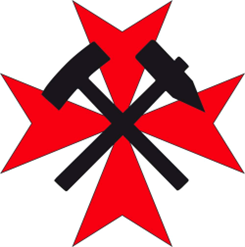Many rescue organizations from around the world and especially eastern Europe have integrated the crossed hammer and pick along with the Maltese cross as a part of their mine rescue logo. Mining has a long and tragic history, particularly in Europe where mining has been ongoing for millennia. Much of the legislation, rescue equipment and procedures followed globally originated in Europe as a result of countless catastrophic mine tragedies. It is fitting that so many rescue organizations have adopted a logo which reflects rich history and deep meaning.
The crossed hammer and pick are the international symbol of mining. The symbol represents the traditional tools of the miner which were the hammer and chisel. The symbol was first identified in Czechia in or about the 12 century. This symbol was later commonly found associated with coal mining in Czechia in the 13 and 14 centuries.
As to the origins of the Maltese cross, it is believed to have originated in Italy in the 11th century; furthermore it is known to have been forged onto coins dating back to the 15th century. The emblem has had religious connotations throughout its history. It is the symbol of chivalry and emergency response and is associated with St John Ambulance and the Most Venerable Order of the Hospital of Saint John of Jerusalem.
Mine rescue organizations in Eastern Europe indicate the points of the cross represent the essential attributes of mine rescuers and these are: piety, justice, charity, tolerance, resourcefulness, courage, thoughtfulness and modesty. Without doubt these are some of the qualities that many mine rescue organizations use in their selection process.
It is no surprise that Europeans maintain the profound respect for mines rescuers they do. They fully understand the dangers that miners are/were exposed to and the risks the mine rescuers continue to face when responding to emergencies.

